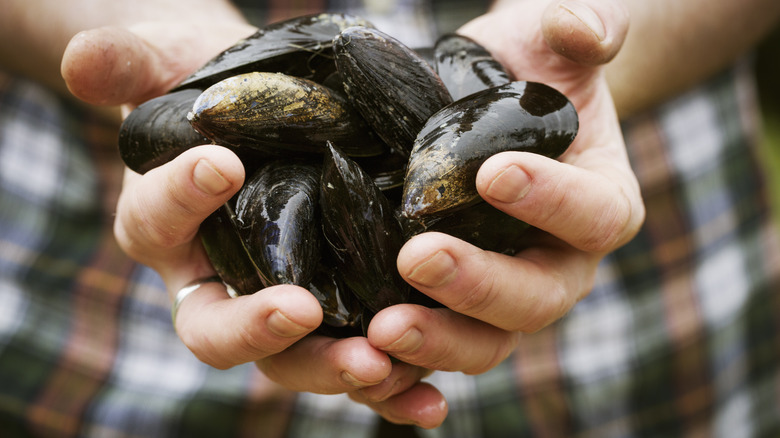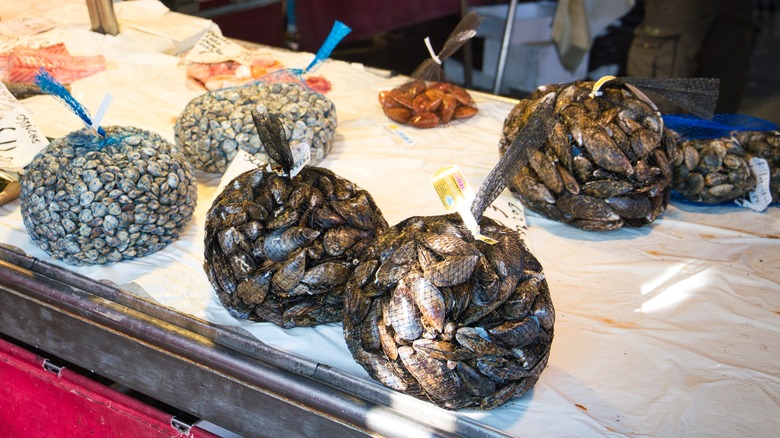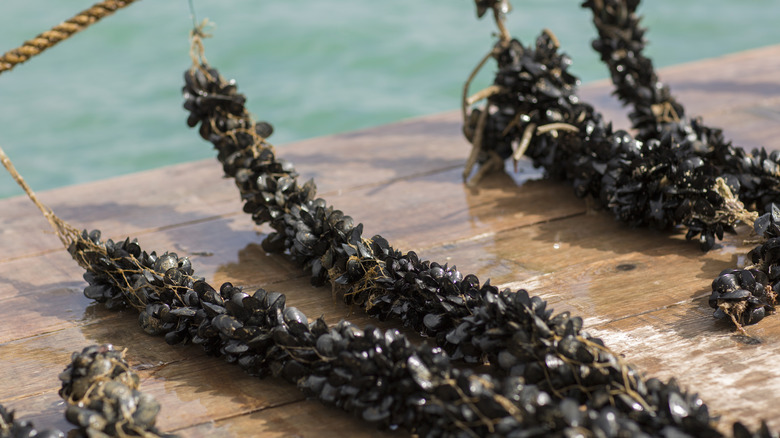The Biggest Mistake You're Making When Picking Out Mussels
Despite Anthony Bourdain's cautionary advice about eating mussels at a restaurant, these shellfish can make for a delicious and quick meal with some preparation. If they are fresh and from a trusted source, we can simple moules-frites at any time — even during months that don't end in the letter "R." Steamed with garlic, white wine, and butter, a bowl of mussels, crusty bread, and your fingers are all that's needed to make life a little better.
Food Republic consulted an expert, Aris Tuazon, the chef and owner of the Filipino-Spanish tapas restaurant 87 Ludlow in New York City, to find out what to look for when shopping for these little mollusks. According to Tuazon, "One mistake people often make when picking out mussels is not checking the harvest tag date." Didn't know they had one? You're not alone!
Each mesh bag of mussels that fishmongers sell should have a harvest tag attached. This tag is part of a state and U.S. Food and Drug Administration program that indicates the body of water from which the shellfish came, the date it was harvested, and when the distributor shipped it out. The program also enables officials to track potentially dangerous shellfish in the market by following the chain from harvest to distributor, thus preventing additional people from getting sick. Tuazon advises shoppers to "look for the harvest date and the pack date, which are both circled on the tag," and to avoid purchasing mussels without one.
Qualities to look for when purchasing mussels
If the mussels have the harvest tag attached and it's recent, Chef Aris Tuazon suggests examining the quality of the shellfish. Whether you plan to eat them raw or cooked, do not purchase mussels that have died during storage. Once dead, shellfish spoil quickly, and although they will eventually emit a foul odor, you may not detect it immediately. Cooking and consuming dead mussels poses a severe health risk, potentially leading to shellfish poisoning. Fishmongers should display mussels and other shellfish on ice, with their shells being wet and shiny without any chips or cracks.
At the market, Tuazon advises: "The most important quality when looking for mussels is to make sure all the shells are closed." Mussels with open or half-open shells are dead, and should be avoided. Give partially open shells a pinch or tap to see if they close, indicating the mussel is still alive (albeit a little lazy). If the shells remain open, the mussels are dead.
Please note that this test should be repeated at home before cooking the shellfish, as they can die before you get them into the pot. Once home, try Ina Garten's flour hack to clean the mussels, ensuring your favorite recipe doesn't end up gritty.
Questions to ask when purchasing mussels
While much information can be gleaned from the tag, Aris Tuazon notes that a reputable fishmonger should also be able to answer additional questions about the mussels, such as whether they're farm-raised or wild-caught. The purveyor should be as interested in where the shellfish are harvested as their customers, and be eager to share that knowledge with you. If this is not the case, consider shopping elsewhere.
While both varieties contribute to cleaning our waterways and are delicious, wild mussels possess a more robust flavor, and you may have a preference. You can typically discern whether the mussels were cultivated since farm-raised mussels tend to be "cleaner," without hairy beards and barnacles attached to the shells. Both types are safe to eat once the mussels are cleaned and the dead ones removed, but wild mussels may require more labor and time, and you should know what you're signing up for.
Once you're satisfied with your purchase, it's time to cook! If you're in the mood for a spicy dish, try this Mediterranean mussel recipe steamed in beer and sauteed with chorizo, or a warming bowl of Thai-style mussels with lemongrass. Either recipe will have you mopping up the bowl with crusty bread.



